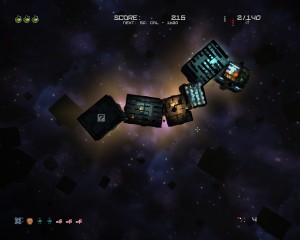Cargo Commander that came out a few months ago by Serious Brew was an attempt at bridging rogue-like design with the sometimes obsessive pursuit of high scores.
When it comes to rogue-like design, I’m all for taking inspiration and design and seeing how far you can stretch it. We’ve gotten some amazing games that way such as Demon’s Souls, The Binding of Isaac and FTL. But unfortunately this is not a case of combining chocolate with peanut butter.
Working 9 to 5:
Cargo Commander’s story line follows the player as a character performing the job of the game title. As a cargo commander, it’s your job to scavenge containers for miscellaneous objects to bring back to the home office. In your floating spaceship/home, you’ll travel the Universe looking for everything from missing socks to coffee cups.
The gameplay consists of you making it through waves of containers. The containers slam into your home and each other forming a level. You have to travel through them looking for items to bring back while watching out for aliens.
Using your drill you can break down walls and can even float around in space for a few seconds to get around. After a predetermined time, the containers will begin to break apart, forcing you to quickly return to your home and start the next wave. Killing aliens will give you red caps that are the game’s currency; they can be used back at your home to upgrade your character or weapons.
Each galaxy has 12 waves of escalating difficulty and dying will force you back to the first wave with all upgrades lost. This is where part of the rogue-like design comes in, along with the high score chasing.
For each item you bring back or alien killed, will earn you points which are factored into a high score table for bragging rights. Dying will end your run and your body will remain at where you died along with any caps on you for other players to find on their run. Likewise while you’re playing you may stumble on the corpses of other players.
The rest of the rogue-like design is factored in by how progression works and the randomized levels. Each new type of item you find gives you experience points and when you earn enough you’ll get a promotion. Promotions are effectively upgrades that are always on freeing you from spending red caps on them.
Each galaxy when created will have up to six different items of various rarities available. This means that you can’t just play one galaxy over and over again and find everything. Traveling to a new galaxy requires the player to find a sector pass, which each galaxy has one.
Exploring new galaxies is where the randomized levels come into play. Galaxies are generated by the galaxy’s name. What happens is that when you want to go to a new galaxy, you input a name and then the system generates a new 12 wave galaxy along with what items you can find.
Now it’s important to note that the galaxy itself does not have random level design, once you’ve gone through one galaxy, it will have the same exact pattern for each replay. But since there is no limit to the naming conventions, there is an infinite # of levels to play.

In this zoomed out screenshot, you can see how the various cargo containers take on the shape of a level.
While having a huge # of levels to play sounds good in theory, the problem comes down to motivating the player to keep playing and the clash between the rogue-like elements and the high score.
Culture Clash:
The problem with Cargo Commander is that the rogue-like elements don’t work with the pull of high score and the progression model.
Every galaxy that you play follows the same pattern of escalating difficulty. Meaning that regardless of your rank, you’re going to have to go through several waves of boring gameplay before things pick up. There’s no way to turn on a “hard mode” as that would get in the way of allowing anyone to compete for high scores in any galaxy.
The progression system only works with new item types that you find, and as you go up in rank, you’ll have less of them available. The level designs are too basic to really challenge someone and aren’t varied enough to make you see something new after several hours of play. That leaves the player with going through sectors doing the same thing over and over again hoping to find new items.
There is a mode which plays out as a survival mode, where there is no home to return to. But once again, the cargo designs and challenges are too limited to make you feel like you’re being challenged with new content.
The worst part is that the high score system is very limited, since each sector is made up of just 12 waves. That means is that there is a set limit to how many items someone can pick up or aliens they can farm for more points. It would have been better to keep with the rogue-like nature and have more waves of escalating difficulty and a chance at finding more items.
While limiting the # of waves is great for people looking for a casual time, forcing someone to stop a good run at an arbitrary point makes it hard to feel motivated to go after a high score.
In the end, we’re left with a game that tries to appeal to both fans of rogue-like design and casual fans, but fails both parties. The game is too simple and repetitive to attract rogue-like fans, while the progression model requires too much of a grind for casual players.
Sadly not even the prospect of traveling around in space fighting aliens can make a 9 to 5 job exciting.



